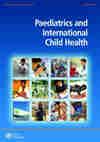一名妊娠26周的先天性军性肺结核合并慢性肺病需要CPAP的婴儿在出生第104天被诊断为先天性肺结核:通过检测其母亲卵巢钙化证实了先天性肺结核
IF 1.4
4区 医学
Q3 PEDIATRICS
引用次数: 0
摘要
婴儿结核病(TB)的早期诊断很重要,但由于其症状通常是非特异性的,因此经常被遗漏。病例介绍:一名尼泊尔男婴在妊娠26周出生,体重1227 g(第97厘位),出生后立即被送入新生儿重症监护病房(NICU)进行早产治疗。第8天拔管后,患者血氧饱和度变得不稳定,需要鼻腔持续气道正压供氧3个月。在第104天,由于呼吸状况没有改善,需要进一步的详细评估。计算机断层扫描显示双肺野散在的粟粒性结节。喉部直接吸痰的结核分枝杆菌和结核聚合酶链反应(PCR)的抗酸染色证实结核分枝杆菌。因此,在第105天,他被转到三级医院接受进一步的重症监护。病理结果提示由于慢性子宫内膜感染而累及胎盘结核。此外,母体腹部CT扫描显示双侧卵巢钙化病变。完成抗结核化疗,3个月后出院。在18个月大的时候,没有任何后遗症,他的发育几乎正常。在新生儿重症监护室暴露的婴儿或医务人员没有发生继发性结核病。结论对于持续呼吸窘迫的新生儿,儿科医生应将结核感染作为鉴别诊断。CLD:慢性肺病;CRP: c反应蛋白;CT:计算机断层扫描;IGRA:干扰素γ释放试验;IVF-ET:体外受精-胚胎移植;N-CPAP:鼻腔持续气道正压通气;NICU:新生儿重症监护病房;PCR:聚合酶链反应;PROM:膜早破;结核病:肺结核;WBC:白细胞。本文章由计算机程序翻译,如有差异,请以英文原文为准。
An infant of 26 weeks gestation with congenital miliary tuberculosis complicated by chronic lung disease requiring CPAP was diagnosed on Day 104 of life: congenital tuberculosis was confirmed by detection of calcified ovaries in his mother
ABSTRACT Introduction Early diagnosis of tuberculosis (TB) in infants is important but is commonly missed because the symptoms are often non-specific. Case presentation A Nepalese male infant born at 26 weeks gestation and weighing 1227 g (97th centile) was admitted to the neonatal intensive care unit (NICU) immediately after birth for the management of his prematurity. After extubation on Day 8, his oxygen saturation became unstable and he required nasal continuous positive airway pressure with oxygen for 3 months. On Day 104, further detailed evaluation was required because there was no improvement in his respiratory condition. A computed tomography (CT) scan demonstrated scattered miliary nodules in both lung fields. Acid-fast staining for the mycobacteria and TB polymerase chain reaction (PCR) of the sputum obtained directly by laryngeal aspiration confirmed Mycobacterium tuberculosis. On Day 105, he was therefore transferred to a tertiary care hospital for further intensive care. Pathology findings suggested placental involvement with TB owing to chronic endometrial infection. In addition, a maternal abdominal CT scan demonstrated bilateral calcified lesions in the ovaries. He completed antituberculous chemotherapy and was discharged 3 months later. At 18 months of age there are no sequelae and his development is almost normal. None of the infants or medical personnel who were exposed in the NICU developed secondary TB. Conclusion In neonates with persistent respiratory distress, neonatologists should consider TB infection as a differential diagnosis. Abbreviations CLD: chronic lung disease; CRP: C-reactive protein; CT: computed tomography; IGRA: interferon-γ release assay; IVF-ET: in vitro fertilisation-embryo transfer; N-CPAP: nasal continuous positive airway pressure; NICU: neonatal intensive care unit; PCR: polymerase chain reaction; PROM: premature rupture of membranes; TB: tuberculosis; WBC: white blood cells.
求助全文
通过发布文献求助,成功后即可免费获取论文全文。
去求助
来源期刊

Paediatrics and International Child Health
PEDIATRICS-
CiteScore
3.30
自引率
0.00%
发文量
19
审稿时长
6-12 weeks
期刊介绍:
Paediatrics and International Child Health is an international forum for all aspects of paediatrics and child health in developing and low-income countries. The international, peer-reviewed papers cover a wide range of diseases in childhood and examine the social and cultural settings in which they occur. Although the main aim is to enable authors in developing and low-income countries to publish internationally, it also accepts relevant papers from industrialised countries. The journal is a key publication for all with an interest in paediatric health in low-resource settings.
 求助内容:
求助内容: 应助结果提醒方式:
应助结果提醒方式:


